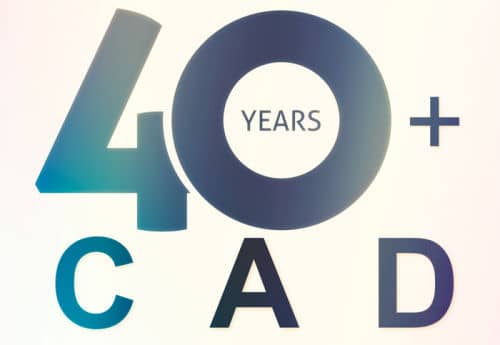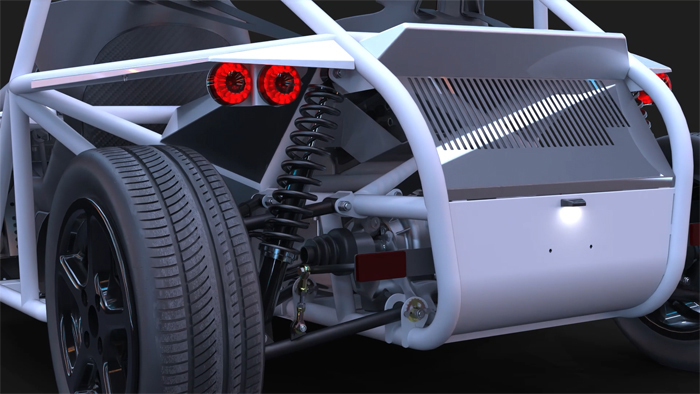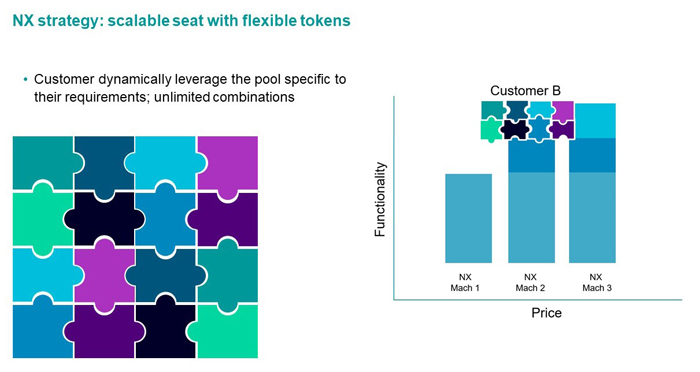
Siemens Digital Industries Software is one of the leading global vendors of engineering software which in the beginning was almost all about CAD, the acronym for Computer Aided Design. During the past 15 years Siemens has become a leading vendor mainly after the acquisition of some of the oldest industry software companies in the United States. Unigraphics with today’s NX software was the biggest among them.
In this series about 40+ years of CAD, Siemens took the chance to be part of it and provided me with an interview that I had at the end of the year 2021. My conversation partners were George L. Rendell, Vice President, NX Design, Product Management and Product Marketing, and Paul Brown, Senior Marketing Director of Product Engineering Software. Both are for many years more than familiar with this software and have a good understanding of where it comes from as well as where it is going to.
The interview was for some part an historical look back. But mainly it was focusing on the present and on the strategy of Siemens for the Cloud and for the flexibility and openness that customers need for the future.
It all started 1972 with UNIAPT, one of the world’s first CAM end-user products, developed by the company United Computing, and the first release of UNIGRAPHICS 1975 as one of the early CAD programs. McDonnell Douglas took over United Computing with this CAD/CAM foundation 1976 and added interactive solid modeling with UniSolids 1978.
A few years later, 1982, I-DEAS was born at SDRC. It was the approach to using geometric data of parts for the simulation of their behavior, and it was the second arm of what 2001 with Unigraphics merged into NX, a few years before Siemens took over the whole software in 2007. It was very important to have both origins for NX, not only the CAD-part. Because this might be one of the good reasons, why NX is not only still alive but important for the industry on its way to the future of engineering.
The Talk (Late November, 2021):
Ulrich Sendler: George and Paul, looking back into the history of NX and of your company, how would you describe the beginning of CAD?
George L. Rendell: It may be hard to believe, but the genesis of CAD was not the design. It was the need of having geometry data for automated NC-programming – which was the origin of Unigraphics – and for simulation instead of testing hardware prototypes – which was the origin of I-DEAS. These benefits were much more urgent, but in the following years the software of course had to enable the industry to replace the drawing board and become more efficient in design. The most important point of being successful as a vendor was to permanently innovate our software because of the also permanently and ever faster changing requirements of the users.

George L. Rendell, Vice President, NX Design, Product Management and Product Marketing

Paul Brown, Senior Marketing Director of Product Engineering Software
Paul Brown: One other thing to think about is in the early days of CAD we were not only focused on software innovation. On top of the software innovation for a long time running CAD required specialist hardware which was constantly evolving. Before you could use the software with any device, we had to go through many years, where the hardware requirements stood in the foreground. For example, in the UK you had to pay 500,000 pounds for a computer, the graphics environment and all the other equipment you needed for one CAD station. Then as time moved on operating systems like UNIX came out, and we had to make sure the software ran on all the different Unix workstations which had all their proprietary operating systems. Today we have common operating systems like Windows and of course the emergence of the cloud is a fact. So, in the beginning there were many factors we had to manage successfully to not only stay in the business but be successful.
Ulrich Sendler: How did your company find the way to distinguish the most important requests of your customers to decide for the right innovation at the right time?
Aerospace, Automotive Consumer Goods – All Industries Adopted the Digital Twin
Ulrich Sendler: Was there a difference in how quickly industries or disciplines adopted the new technology compared to others?
George: The early adopters were clearly the aerospace companies. Their complex products and processes forced them earlier than others to a fundamental change. But soon the automotive groups became the ones that were pushing it forward over a long period of time. And if you looked inside the companies, you could see the body groups using 3D surface modeling when the majority was still having 2D drawings and 2D thoughts in a 3D space. Up to the mid-eighties or even the nineties. The body groups were often the most challenging users to us.
Paul: You can also see that smaller companies, often delivering components to the bigger ones, often are innovating faster. There is a kind of freedom at the small customer’s side to invest and innovate, while it takes a bit longer in the big groups. The nice thing for us is we have both kinds of customers and users, who always mutually stimulate each other.
George: The same is true for the different kinds of industries. First aerospace and then automotive, but in recent years we see innovation in terms of the marry of mechanics, electronics and electrics coming more and more from our electronics and consumer goods customers. Smart phone and smart phone towers – that kind of users led us to acquire Mentor Graphics and closely integrate their software with NX.
Ulrich Sendler: What would you say is CAD today?
George: Every company is now thinking and developing products of any kind completely in 3D. That’s why we can truly talk about a comprehensive digital twin. The whole products are 3D today. That’s why our integrated design, manufacturing, and simulation software NX fits so well to the customers’ needs.
Paul: A good example for how companies of all sizes can benefit from pulling the whole process together can be seen with a company called Lightway. They are a dynamic company based in Niederzissen Germany. They use NX to design complex components, and have adopted Additive Manufacturing to allow them to generate new products faster. Using NX generative design and topology optimization, simulation, light weighting with tools like lattice design and then into the Additive Manufacturing tools allows them to respond quickly to their customer’s needs. It gives them the chance to use a single solution with no data translation to get their jobs done. I would also say, it’s not just about additive manufacture but traditional subtractive manufacture too. That’s all part of the heritage we have in the industry to be able to bring these things together to meet our customer’s needs.
George: This example is also showing the typical way how new technology and new kinds of integration find their way into the industry. They first must work best in a close cooperation with a customer. Then when the story is published, other parts of the industry start to take notice and then will adopt those innovations and thinking in their engineering processes.
Easy Configuration and The Flexibility of The Token Licensees
Ulrich Sendler: Meanwhile there are so many software-tools integrated in NX, that it is hard to keep the overview. But I saw this blue and green wheel which puts them in clear categories. Can you explain that to the readers?
George: The wheel shows very nicely, how comprehensive the digital twin can be, generated with NX. There are the disciplines of mechanical and electrical engineering as well as the manufacturing part of the value chain. And on the bottom of the wheel, you find the industry specific processes as the foundation on which you build your use of all the functionality that NX delivers.

Advances in graphics rendering allow designers to visualize the digital twin complete with in scene lighting to get a clear view of their product

Allowing organic shapes to be mixed with traditional solid geometry allows companies to explore new approaches to product production and get maximum benefit from new solutions like Additive Manufacture

The “Green Wheel” NX

Customers select specific tokens from the pool and add them to their NX Mach 1, 2 or 3 license configuration for only as long as they need them.
Because there is so much potential in the whole system, we made it easier for our customers to configure mainly with two very important steps. One is to pre-configure certain bundles of functionalities, which we now call NX MACH, ranging from NX MACH 1 to NX MACH 3. These bundles are aiming at the special roles that users have within their company processes. We have bundles for quite a number of industries that have different kinds of processes and therefore different needs. The second step was to offer so called Token licensees. So, no matter which configuration at a customer company is installed or used via the cloud, token licensees can be added. The customer may buy 50 Tokens or a 100 on a yearly basis, and within this package he can at any time chose some function or special tool, that is not part of his MACH-bundle. Right now, we have more than 70 design products within the token pool, and there will be more over the coming months and years.
Paul: This is a unique way of giving our customers more flexibility in the use of the software. They don’t have to upgrade their installed package just because they need a new function only for one month or for trying it out. It gives flexibility in every direction: scaling up to a higher functionality, or trying some model based systems engineering functionality to start a new way of engineering in a part of the team.
Ulrich Sendler: What do you think will the term CAD mean in five or ten years from now?
George: I think, terms like CAD and CAM and even PLM will not play this role anymore. Think of the project we made with Lightway. It is not done with design; it is not done with simulation and not with automated additive manufacturing. You need all the tools together that are around today. And more, you not only need the tools from one vendor but everything that comes to the market. Therefore, it is also very important to have an open platform that allows this. What will CAD mean does not seem to be the right question. It is all about engineering!
Paul: And it’s all about innovation. With customers implementing CAD and all the other software tools we have developed over all these almost 50 years has made the industry and their processes look completely different. And this is what our ongoing innovation in software will continue to fulfill: help engineers to be innovative and find new ways to develop new products and services.
